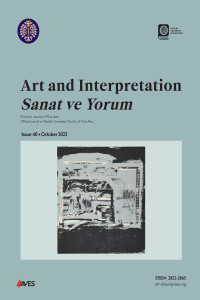Analysis of Diego Velazquez’s “Rokeby Venus” According to the Method of Ichonographic and Iconological Art Critisizm
Abstract
Diego Velazquez, one of the important painters of the Baroque period, is an artist who draws
attention with his realistic and natural expression, use of different light and perspectives in his
works. The artist, who brings together intellectual and mythological subjects in his works, has
gained fame especially with his portraits. The work named “Rokeby Venus,” which is among the
works of the artist and still preserves its mystery, has an important place in the art of painting
both in Spain and in the world. Differences such as the fact that Venus was drawn with her back
to the audience for the first time until that day, mastery in the technique used, and the mythological
meanings it contains gave the work a multi-layered quality. In this study, based on Erwin
Panofsky’s “Iconographic and Iconological Art Criticism” method, the work of “Rokeby Venus” by
Velazquez was analyzed. Panofsky’s method is a method that has been accepted in the fields of
art and art education and continues to be used today. While analyzing the work, preiconographic
description, iconographical analysis, and iconological interpretation were used. It has been seen
that with this method, works of art can be evaluated more accurately. With the research done,
various meanings of the work named “Rokeby Venus” were encountered and it was concluded
that it is a masterpiece that still preserves its mystery.
References
- Akpang, C. E. (2020). Writing about art: Addressing the problem of art appreciation and criticism. Nigeria Universities/Colleges International Journal of Education and Research. 8(2).
- Barrett, T. (2012). Sanatı eleştirmek, günceli anlamak. Hayalperest Yayınevi.
- Beksaç, E. (1986). Velazquez’in sanatında sembolik ve didaktik anlamlar [Yayınlanmış Doktora Tezi, İstanbul Üniversitesi Sosyal Bilimler Enstitüsü].
- Cömert, B. (2019). Mitoloji ve ikonografi. De ki Basım Yayın.
- Honour, H., & Fleming, J. (2020). Dünya sanatı tarihi. Alfa Yayıncılık. Hristova, S. (2017). Notes on the iconography of mediated gestures. HAU, 7(1), 415–422. [CrossRef]
- Kara, E. (2018). İspanya’nın altın çağında Sevilya kentinin İspanyol sanatındaki yeri. Journal of Awareness, 71–88.
- Micheletti, E. (1968). Velazquez. Grosset & Dunlap, Inc.
- Mitolojik Tanrılar. (2019). Eros (Cupid)/Yunan Mitolojisinde Aşk Tanrısı https://www.mitolojiktanrilar.com/eros-ask-tanrisi/
- Muller, M. G. (2011). Iconography and iconology as a visual method and approach. E. Margolis, & L. Pauwels (Eds.), The sage handbook of visual research methods (s. 283–297) içinde.
- Muller, M. G. (2015). The international encyclopedia of communication. [CrossRef]
- Panofsky, E. (2012). İkonoloji araştırmaları Rönesans sanatında insancıl temalar. Pinhan Yayıncılık.
- Prater, A. (2007). Venus Ante el Espejo. CEEH.
- Shatford, S. (1986). Analyzing the subject of a picture: A theoretical approach, cataloging & classification quarterly, 6(3), 39–62.
- Tükel, U., & Yüzgüller, S. (2018). Sözden imgeye Batı sanatında ikonografi. Hayalperest Yayınevi.
- Velazquez, D. (1647). Aynadaki Venüs [Resim]. https://tr.wikipedia.org/ RokebyVenus
- Vidaurre, C. (1999). Diego Velázquez: La venus d. espejo.
- Wikipedia. (2022, 18 Mart). Cupid. https://tr.wikipedia.org/wiki/Cupid
Erwin Panofsky’nin İkonografik ve İkonolojik Eleştiri Yöntemine Göre Diego Velazquez’in “Aynadaki Venüs” İsimli Eserinin Analizi
Abstract
Barok döneminin önemli ressamlarından biri olan Dieogo Velazquez, eserlerindeki gerçekçi
ve doğal anlatımı, farklı ışık ve perspektif kullanımı ile dikkatleri üzerine çeken bir sanatçıdır.
Eserlerinde düşünsel ve mitolojik konuları bir araya getiren sanatçı, özellikle portreleriyle ün
kazanmıştır. Sanatçının eserleri arasında yer alan ve hala gizemini koruyan “Aynadaki Venüs” isimli
eseri gerek İspanya gerekse dünya resim sanatı içinde önemli bir yere sahiptir. Eserde Venüs'ün o
güne kadar ilk defa izleyiciye arkasını dönmüş olarak çizilmesi gibi farklılıklar, kullanılan teknikteki
ustalık ve barındırdığı mitolojik anlamlar esere çok katmanlı bir nitelik kazandırmıştır. Bu araştırmada
Alman Sanat Tarihçi Erwin Panofsky tarafından geliştirilmiş olan “İkonografik ve İkonolojik
Sanat Eleştirisi Yöntemi” esas alınarak, Velazquez’in “Aynadaki Venüs” isimli eseri analiz edilmiştir.
Panofsky’nin yöntemi, sanat ve sanat eğitimi alanlarında geçerliliği kabul görmüş ve günümüzde
de kullanılmaya devam eden bir metottur. Eser analiz edilirken Panofsky’nin belirlemiş olduğu,
ön ikonografik inceleme, ikonografik çözümleme ve ikonolojik yorum başlıkları dikkate alınmıştır.
Bu yöntemle sanat eserlerinin daha doğru bir biçimde değerlendirilebileceği görülmüştür. Yapılan
araştırma ile birlikte “Aynadaki Venüs” isimli eserin çeşitli anlamlarıyla karşılaşılmış ve günümüzde
hala gizemi korumakta olan bir başyapıt olduğu sonucuna ulaşılmıştır.
References
- Akpang, C. E. (2020). Writing about art: Addressing the problem of art appreciation and criticism. Nigeria Universities/Colleges International Journal of Education and Research. 8(2).
- Barrett, T. (2012). Sanatı eleştirmek, günceli anlamak. Hayalperest Yayınevi.
- Beksaç, E. (1986). Velazquez’in sanatında sembolik ve didaktik anlamlar [Yayınlanmış Doktora Tezi, İstanbul Üniversitesi Sosyal Bilimler Enstitüsü].
- Cömert, B. (2019). Mitoloji ve ikonografi. De ki Basım Yayın.
- Honour, H., & Fleming, J. (2020). Dünya sanatı tarihi. Alfa Yayıncılık. Hristova, S. (2017). Notes on the iconography of mediated gestures. HAU, 7(1), 415–422. [CrossRef]
- Kara, E. (2018). İspanya’nın altın çağında Sevilya kentinin İspanyol sanatındaki yeri. Journal of Awareness, 71–88.
- Micheletti, E. (1968). Velazquez. Grosset & Dunlap, Inc.
- Mitolojik Tanrılar. (2019). Eros (Cupid)/Yunan Mitolojisinde Aşk Tanrısı https://www.mitolojiktanrilar.com/eros-ask-tanrisi/
- Muller, M. G. (2011). Iconography and iconology as a visual method and approach. E. Margolis, & L. Pauwels (Eds.), The sage handbook of visual research methods (s. 283–297) içinde.
- Muller, M. G. (2015). The international encyclopedia of communication. [CrossRef]
- Panofsky, E. (2012). İkonoloji araştırmaları Rönesans sanatında insancıl temalar. Pinhan Yayıncılık.
- Prater, A. (2007). Venus Ante el Espejo. CEEH.
- Shatford, S. (1986). Analyzing the subject of a picture: A theoretical approach, cataloging & classification quarterly, 6(3), 39–62.
- Tükel, U., & Yüzgüller, S. (2018). Sözden imgeye Batı sanatında ikonografi. Hayalperest Yayınevi.
- Velazquez, D. (1647). Aynadaki Venüs [Resim]. https://tr.wikipedia.org/ RokebyVenus
- Vidaurre, C. (1999). Diego Velázquez: La venus d. espejo.
- Wikipedia. (2022, 18 Mart). Cupid. https://tr.wikipedia.org/wiki/Cupid
Details
| Primary Language | Turkish |
|---|---|
| Journal Section | Research Articles |
| Authors | |
| Publication Date | October 31, 2022 |
| Submission Date | October 4, 2021 |
| Published in Issue | Year 2022 Issue: 40 |
Content of this journal is licensed under a Creative Commons Attribution NonCommercial 4.0 International License


